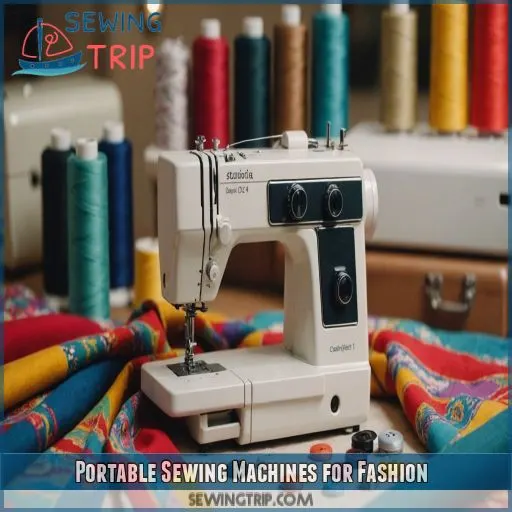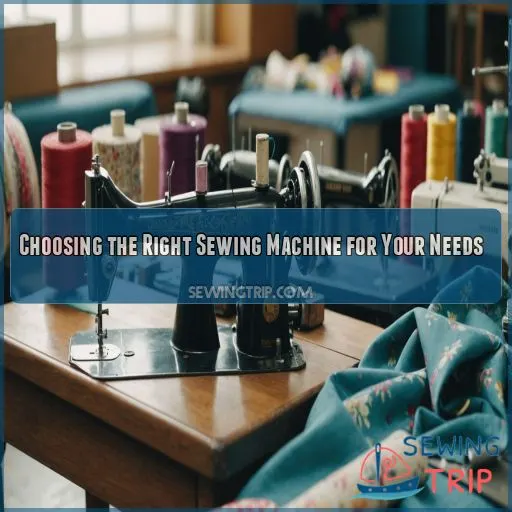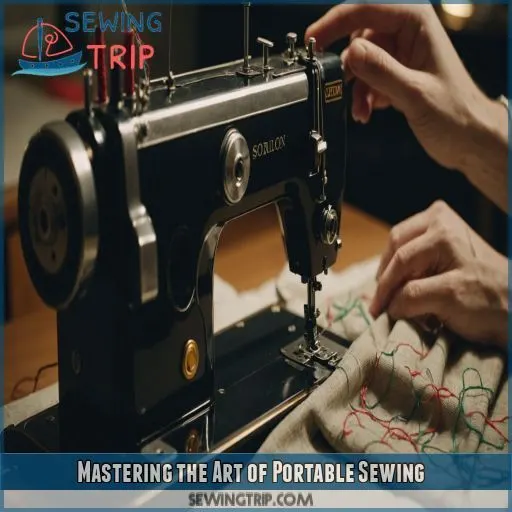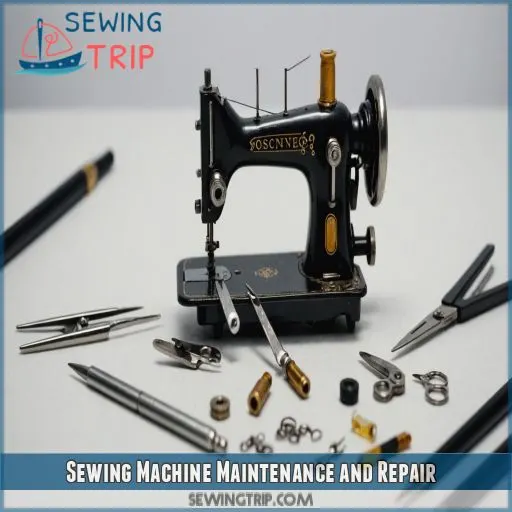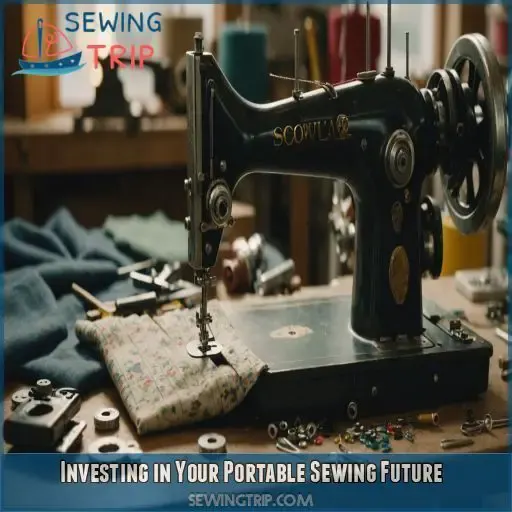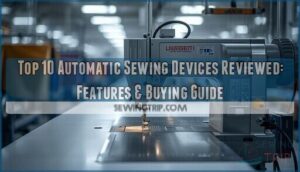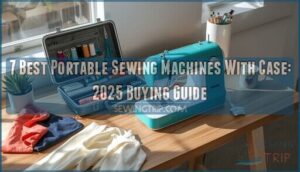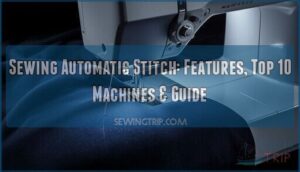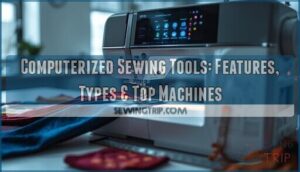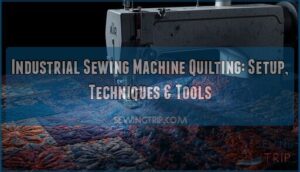This site is supported by our readers. We may earn a commission, at no cost to you, if you purchase through links.
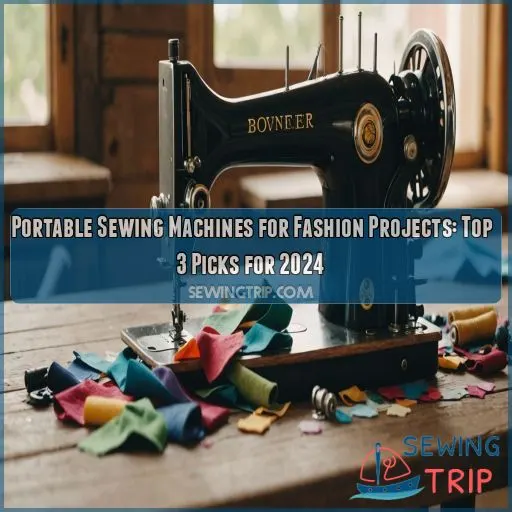
Choosing the perfect companion for your fashion adventures means finding a machine that’s reliable and versatile.
Whether you’re a seasoned pro or a beginner, a portable sewing machine can be your new BFF.
With the right machine, you’ll be whipping up garments, accessories, and home decor items in no time.
But which one to choose?
Look for essential features like a free arm, automatic needle threader, and a variety of stitch options.
Table Of Contents
- Key Takeaways
- Portable Sewing Machines for Fashion
- Choosing the Right Sewing Machine for Your Needs
- Top Portable Sewing Machines for Fashion Projects
- Mastering the Art of Portable Sewing
- Sewing Machine Maintenance and Repair
- Investing in Your Portable Sewing Future
- Frequently Asked Questions (FAQs)
- Conclusion
Key Takeaways
- You’re on the hunt for the perfect portable sewing machine for your Fashion Projects – don’t compromise on power and durability! Look for machines with mostly metal parts, high motor strength, and rigorous durability testing methods to ensure it can keep up with your creativity and busy lifestyle.
- Choosing the right needle is like finding the perfect dance partner – it’s all about compatibility! Consider your fabric type, weight, and desired stitch quality, then pick a needle that’s specifically designed for the job to achieve professional-grade results.
- Don’t let common issues derail your portable sewing adventures! Master DIY troubleshooting fixes, such as tackling thread breakage, fixing loose stitches, and removing fabric jams, to keep your machine humming along, even when you’re sewing on-the-go.
- Investing in your portable sewing future means thinking about your long-term needs and budget – it’s like buying a car; you want one that’ll last, not just get you from point A to point B! Set aside a budget for repair and maintenance costs, invest in quality accessories, and consider upgrading to a more advanced machine as your skills and projects grow.
Portable Sewing Machines for Fashion
If you’re a fashion enthusiast who’s always on the go, you need a sewing machine that can keep up with your creativity and busy lifestyle. Whether you’re a student, a professional designer, or a DIY enthusiast, a portable sewing machine can be your best friend in bringing your fashion projects to life.
Essential Features for Garment Sewing
The thrill of creating your own garments! To get started, you’ll want a portable sewing machine that’s equipped with the essentials. Look for a machine with a free arm, automatic needle threader, and a variety of stitch options. Specialized feet, like a zipper foot or overcast stitch foot, will also make garment construction a breeze.
Power and Durability Considerations
You’re on the hunt for a portable sewing machine that can keep up with your fashion projects. In terms of power and durability, don’t compromise. Look for machines with mostly metal parts, high motor strength, and rigorous durability testing methods. Here are key factors:
- Motor Strength Options: Can it handle thick fabrics and multiple layers?
- Durability Testing Methods: Has the machine been put through its paces?
- Metal vs Plastic: Which materials will withstand regular use?
- Power Consumption Rates: Will it drain your battery or blow your fuse?
Weight and Storage Options for Easy Transport
In the context of portable sewing machines for fashion projects, weight and storage options matter. You want a machine that’s easy to tote around, without sacrificing power and durability. Consider a machine with a measured weight under 20 pounds and invest in a sturdy travel case or portable bag.
| Feature | Janome HD3000 | Juki HZL F300 | Singer Heavy Duty |
|---|---|---|---|
| Weight | 18.7 lbs | 21.6 lbs | 14.5 lbs |
| Dimensions | 16x11x7 in | 17x11x7 in | 15x12x7 in |
| Storage Options | Hard case, soft case | Hard case, travel bag | Soft case, storage bin |
| Portability Score | 8/10 | 7.5/10 | 9/10 |
Choosing the Right Sewing Machine for Your Needs
You’re on the hunt for the perfect portable sewing machine to bring your fashion projects to life, but with so many options out there, it’s easy to get overwhelmed.
Let’s break it down and explore the key factors that come into play when choosing the right sewing machine for your needs.
From mechanical vs. computerized to must-have stitch options and more, we’ll cover the essential considerations to help you make an informed decision.
Mechanical or Computerized – Which is Best?
So, you’re torn between mechanical and computerized sewing machines. Let’s break it down. Mechanical machines offer simplicity, durability, and a lower price point – perfect for those on a budget or who value hands-on control. Computerized machines, on the other hand, boast advanced features like LCD screens and automatic stitch selection, ideal for intricate fashion projects.
Evaluating Your Sewing Experience and Project Type
Your sewing journey is unique, and so are your needs.
Be honest about your skill level – are you a total newbie or a seasoned pro?
Consider the types of projects you’ll be working on most often.
Are you a garment guru or a quilting queen?
Your answers will help you narrow down the perfect portable sewing machine for your fashion projects.
Must-Have Stitch Options for Fashion Projects
- Straight stitch for general sewing
- Zigzag stitch for preventing fraying
- Buttonhole for, well, buttonholes!
- Blind stitch for nearly invisible hems
Top Portable Sewing Machines for Fashion Projects
You’re on the hunt for a portable sewing machine that can keep up with your fashion projects, and we’ve got the inside scoop on the top three picks for 2024. From heavy-duty powerhouses to versatile quilting machines, we’ll explore the best options for sewing on-the-go, so you can create stunning garments and accessories wherever inspiration strikes.
1. Janome HD3000 Heavy Duty Sewing Machine
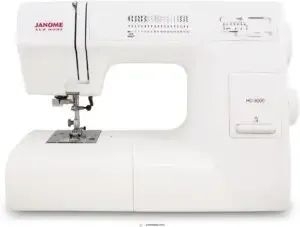
You’re on the hunt for a reliable sidekick for your fashion projects! The Janome HD3000 Heavy Duty Sewing Machine is a top pick for a reason.
It’s packed with features that make sewing a breeze:
- 18 stitches
- Automatic one-step buttonhole
- Jam-proof bobbin system
The Janome HD3000 is a great choice for anyone who wants a durable and reliable sewing machine.
It’s also easy to use and transport:
- Compact and lightweight design
- Built-in needle threader
While it might feel a bit stiff at first, this is a small price to pay for the durability and smooth operation it offers.
Best For: The Janome HD3000 is best for sewers who need a durable, reliable machine for general sewing projects and heavier fabrics.
- Durable and reliable construction.
- Easy to use and transport.
- Handles heavy fabrics and multiple layers with ease.
- Might feel a bit stiff compared to other models.
- Not ideal for quilting or specialized techniques that require fancy feet.
- Limited stitch options compared to some other sewing machines.
2. Juki HZL F300 Sewing Quilting Machine
The Juki HZL F300 Sewing Quilting Machine – a powerhouse for fashion projects on-the-go! With 106 stitch patterns, 16 automatic buttonholes, and a free arm, you’ll be whipping up garments in no time. Its box feed system and wide extension table make handling fabric a breeze. Plus, the intuitive controls and clear screen will have you sewing like a pro in minutes. At 25 pounds, it’s a tad heavier, but trust us, it’s worth the extra weight for the freedom to create anywhere.
Best For: The Juki HZL F300 is best for beginners and sewers who want a versatile machine with a wide range of stitches, automatic features, and a smooth sewing experience.
- Easy to use with intuitive controls and a helpful manual.
- Offers a wide range of speed control for different fabrics and projects.
- The box feed system makes handling fabric a breeze.
- No knee lever for lifting the presser foot (can be purchased separately).
- Limited accessories compared to higher-end models.
- No light in the throat area for better visibility.
3. Singer Heavy Duty Sewing Machine
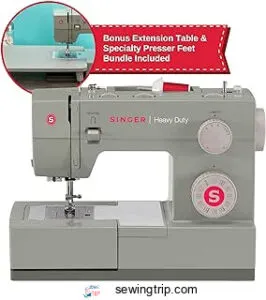
The Singer Heavy Duty Sewing Machine – a powerhouse in portable sewing! With its enhanced piercing power and 110 stitch applications, you’ll be tackling thick fabrics and multiple layers like a pro. The top drop-in bobbin and clear view cover make thread monitoring a breeze. Yes, it’s a bit noisy and heavy, but trust us, the results are worth it. Get ready to tap into your creativity and take control of your sewing projects with this reliable workhorse.
Best For: This sewing machine is perfect for crafty DIYers, small business owners, and sewing enthusiasts who need a reliable workhorse for tackling thick fabrics and multiple layers.
- The Singer Heavy Duty Sewing Machine boasts enhanced piercing power with a stronger motor, allowing users to easily sew through multiple layers and thicker fabrics .
- With 110 stitch applications, this machine is versatile and can handle a wide range of sewing needs, from simple repairs to complex projects .
- The machine’s full metal frame provides stability and durability, ensuring that it will withstand frequent use and last for years to come .
- Some users have reported that the throat space is not wide enough for certain types of work, which can be a limitation for those who need to work with larger or more complex projects .
- The machine is a bit noisy, especially at higher speeds, which can be a drawback for those who prefer a quieter working environment .
- The machine is heavy, making it less portable and more difficult to move around, which can be a concern for those who need to take their sewing machine to classes or workshops .
Mastering the Art of Portable Sewing
As you master the art of portable sewing, you’ll discover the freedom to create anywhere, anytime – whether that’s in a cozy home studio or on-the-go at fashion events. To reach your full sewing potential, you must learn the ins and outs of choosing the right accessories, techniques, and tools to guarantee efficient and high-quality sewing.
Tips for Choosing the Right Accessories
Your trusty sewing machine is only as good as the accessories you pair it with. Mastering portable sewing is all about the extras. Here are some essentials:
- Invest in a variety of sewing needles for different fabrics and projects.
- Choose the right presser feet for your machine and project type.
- Don’t skimp on thread selection – it can make or break your stitches.
- Keep a stash of bobbin options on hand to avoid mid-project frustration.
Techniques for Efficient and High-Quality Sewing
You’ve got your portable sewing machine, now it’s time to master the art of efficient and high-quality sewing. To boost your skills, focus on Sewing Speed Tips, Fabric Selection, and Thread Management. Here are some key techniques to get you started:
| Technique | Description |
|---|---|
| Interfacing Techniques | Stabilize fabrics for smooth sewing |
| Seam Finishing | Prevent fraying with a serger or zigzag stitch |
| Threading a Mini | Use a needle threader for effortless threading |
| Automatic Thread Cutter | Save time with this convenient feature |
| Needle Down Position | Easily pivot fabric for smooth curves |
Essential Tools for Sewing On-The-Go
You’re mastering the art of portable sewing! Now, let’s talk tools. A well-stocked sewing kit is your BFF on-the-go. Here are three must-haves:
- Travel-friendly iron: Invest in a compact, portable iron that’s easy to pack and won’t weigh you down.
- Mini tool kit: Pack a mini tool kit with scissors, pins, and needles to keep your projects on track.
- Desk lamp: A compact desk lamp provides perfect lighting for sewing in any environment.
Sewing Machine Maintenance and Repair
Regular maintenance is key to a long and happy relationship with your portable sewing machine.
Think of it like getting your car serviced, but with fewer oil stains and more threads.
By staying on top of tune-ups and learning some basic DIY troubleshooting, you’ll be able to fix common issues.
This will keep your machine humming along, even when you’re sewing on-the-go.
Importance of Regular Servicing and Tune-Ups
Now that you’re mastering the art of portable sewing, let’s talk maintenance. Think of your sewing machine like a car – it needs regular tune-ups to run smoothly. Neglect it, and you might be facing costly repairs down the line. Here’s a rough guide to get you started:
| Machine Type | Tune-up Frequency | Servicing Cost Factors |
|---|---|---|
| Mechanical | Every 1-2 years | Usage, storage conditions |
| Computerized | Every 5-7 years | Complexity, software updates |
| Heavy-Duty | Every 1-3 years | Intensive use, long distance damage |
Stay on top of maintenance to avoid headaches and keep your machine purring like a kitten.
DIY Troubleshooting for Common Issues
Don’t let common issues derail your portable sewing adventures. When trouble strikes, take a deep breath and try these DIY troubleshooting fixes:
- 1. Tackle thread breakage by checking your tension dial and adjusting as needed.
- 2. Fix loose stitches by rethreading your machine and tightening the bobbin.
- 3. Remove fabric jams by gently tugging on the fabric and rethreading your machine.
Where to Find Local Repair Shops and Services
Now that you’ve mastered DIY troubleshooting, it’s time to find a trusty sidekick for your sewing machine – a local repair shop! You can search online for "sewing machine repair near me" or check with local fabric stores for recommendations. Here are some options:
| Option | Description |
|---|---|
| Independent Fabric Stores | Often partner with local repair technicians |
| Online Directories | Websites like Yelp or Google Maps can help you find repair shops |
| Sewing Machine Dealers | May offer repair services or recommend local technicians |
| Sewing Communities | Online forums or social media groups can connect you with local sewing enthusiasts who know reliable repair shops |
Investing in Your Portable Sewing Future
Now that you’ve got your portable sewing machine and know how to keep it running smoothly, it’s time to think about investing in your sewing future. Future-proofing your purchase means thinking about your long-term needs and budget. Think of it like buying a car – you want one that’ll last, not just get you from point A to point B.
Here are some things to keep in mind:
- Set aside a budget for repair and maintenance costs down the line (about $120 per year).
- Invest in quality accessories like specialized feet, needles, and threads that’ll make your projects shine.
- Consider upgrading to a more advanced machine as your skills and projects grow – you might find you need more stitch options or a stronger motor to tackle those fashion projects.
Frequently Asked Questions (FAQs)
What sewing machines do fashion houses use?
Behind the catwalk curtain, fashion houses rely on industrial-strength sewing machines like Juki’s DDL-8700 and Brother’s DB2-B747-05 to bring their designs to life, with precision and speed being the ultimate style statements.
Are mini sewing machines good for making clothes?
While mini sewing machines are super portable and convenient, they’re not ideal for making clothes. With only a straight stitch and no reverse function, you’ll be limited in your design options and might end up frustrated.
What sewing machines are used in next in fashion?
You’re ready to slay the fashion game! On Next in Fashion, designers often use high-end sewing machines like the Juki HZL-F300, Brother CS5055, and Janome HD-3000, which offer precision, speed, and versatility for their fashion projects.
Can you make a dress with a mini sewing machine?
Imagine whipping up a dress on a mini sewing machine – sounds like a fashion fairy tale! Unfortunately, with only a straight stitch and no reverse function, it’s more like a frustrating DIY disaster waiting to happen.
What is the ideal weight for a portable sewing machine?
You’re on the hunt for the perfect portable sewing machine! Ideally, you want one that’s lightweight, around 10-15 pounds, making it easy to tote around without sacrificing power or performance. Happy sewing!
Can portable sewing machines handle thick fabrics and denim?
Think again if you assume portable sewing machines are wimps! While they may not be as mighty as their industrial cousins, many can handle thick fabrics and denim with ease, giving you freedom to create on-the-go.
How do I choose the right needle for my project?
Choosing the right needle is like finding the perfect dance partner – it’s all about compatibility. Consider your fabric type, weight, and desired stitch quality, then pick a needle that’s specifically designed for the job!
What are the benefits of using a computerized sewing machine?
With a computerized sewing machine, you’ll open up a world of creative freedom! You’ll enjoy effortless stitch selection, automatic tension, and precise control, making it easier to tackle complex projects and achieve professional-grade results.
Can I use a portable sewing machine for quilting projects?
Coincidentally, many portable sewing machines can handle quilting projects, but you’ll want to check the machine’s capabilities and stitch options first. Look for a machine with a variety of stitches and a large sewing field.
Conclusion
You’ve made it – you’re now a portable sewing rockstar!
With the perfect machine by your side, the fashion world is your playground.
Choosing the right portable sewing machines for fashion projects can be overwhelming.
But our top 3 picks have got you covered.
Whether you’re a pro or a newbie, these machines will help you whip up garments in no time.
Happy sewing with your new BFF – the ultimate portable sewing machine for fashion projects!

